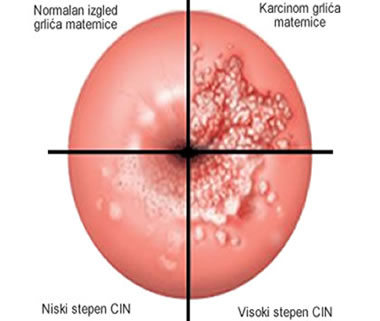Blog
Cervical cancer
Cervical cancer is a malignant tumor that results from abnormal cell growth in the lower uterus. It develops over a long period of time, five years or more allowing its timely detection, before becoming invasive and spreading.
Frequency; one of the most common malignant tumors of women, which is the third most common in our region (behind breast and lung cancer). There are 16 newly reported cases per 100,000 women annually. It is much less common in developed countries; in US 8th in frequency, UK 12th; most commonly occurs between 35-50 years of age. In the first half of the last century, the goal of early diagnosis was to detect the first symptoms of a disease by which a woman could recognize the existence of cancer. Cervical cancer does not give early symptoms or they are mild and non-specific. The occurrence of premalignant changes in the cervix - the initial form of cancer most often goes without any problems and there is no warning for the woman to tell the gynecologist. In the first half of the last century, the goal of early diagnosis was to detect the first symptoms of a disease by which a woman could recognize the existence of cancer.
Causes of cervical cancer
Through the examination of the causative agent, not one but more risk factors have been identified which increase the chances of the cervical cell to become abnormal and begin to develop as malignant tissue. Risks that can contribute to the onset of this disease include; early onset of sex life, greater number of sexual partners, smoking, immune system diseases, low standard of living, lower educational attainment, inadequate sexual hygiene, poor living conditions and poor health care. One of the most important causes of cervical cancer is Human Papilloma Virus (HPV), a sexually transmitted virus that can cause changes in cervical cells, leading to the development of a malignant tumor. Of course, this does not mean that all women infected with this virus will get cancer, but the fact is that most of those with this type of tumor have infection with this virus.
Most important in the prevention of this disease is the habit of seeing a gynecologist regularly, at least once a year, and having a colposcopic examination and pap smear as part of a gynecological examination, avoiding frequent alteration of sexual partners, and timely and appropriate treatment of genital infections.
Symptoms and therapy
Premalignant changes and early invasive cervical cancer usually do not cause any problems. Symptoms that women with cervical cancer may have are: - bleeding (this is the most common first symptom, whether during a relationship or between two periods, prolonged menstrual bleeding or bleeding after menopause).
- Enhanced white odor wash
- pain, which most commonly occurs in the sacrum or leg as well
- Swelling of the legs.
Unfortunately, these are symptoms of advanced disease.
The goal of today's diagnosis of cervical cancer is to detect a non-invasive stage of Ca PVU in situ or precancerous changes. Applying the methods of examination, colposcopy and cytology (pap test), one can now diagnose a condition that is not yet cancer and is heading in that direction of development. When a colposcopy and a pap test reveal pathological changes, a biopsy of the cervix is done - taking a portion of the tissue to determine the stage of the disease histologically.
Papa test
It is a simple and painless method of taking a cervical smear and examining the cells for inflammation or for the presence of abnormal or cervical cancer cells. The test is best done in the middle of the menstrual cycle, and no vaginal drugs or topical contraceptives should be used before taking the test.
 34
34
 1500
1500
 5
5



